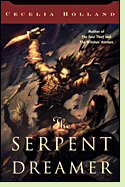The Serpent Dreamer
by Cecelia Holland
Reviewed by David Maclaine

The Serpent Dreamer begins in a very different world than the one Corban Loosestrife left behind at the end of The Witches' Kitchen. Corban has returned to the land he discovered and homesteaded beyond the great Western Sea, but things have changed while he was meddling in the rise and fall of Danish kings. The young warrior named Miska who made his name battling Corban's people is now a powerful chief, his warlike tribe overshadowing the people of Corban's old ally Tisconum. Miska plots to enlarge his power even further, while Corban survives in his village, barely tolerated for the sake of his magical sister, by the hostile chief. Corban's niece Ahanton, daughter of Miska and his sister Mav, is scarcely better inclined toward her strange white-faced uncle. But the time soon arrives when Corban, his native spouse Epashti, and Ahanton must make an epic journey west in search of the mysterious Sun People, linked to a place called Cibala, and an intriguing new food called "maz." Before long we realize that the same strange destiny that brought Corban into collision with kings of northern Europe will bring him face-to-face with a despot who enforces his rule over subject peoples by military means, something more familiar to Corban than to the people threatened with slavery.
Once again, Holland's power to evoke worlds whose basic concepts are unlike our own brings to life and makes believable a long-lost place and time, in this case the tribal life of Pre-Columbian North America. The Serpent Dreamer is the one volume in her Soul Thief series most easily skipped by those looking for Viking Age warfare, but readers who want to follow Corban's story to its end will happily immerse themselves in her plausible recreation of a world known only through archaeological remains and scraps of legend. And we discover once again that the power of male war leaders is sometimes matched by a surprising counterforce. (2005, 336 pages)
More about The Serpent Dreamer at Amazon.comOther novels set in early North America:
She Who Remembers by Linda Lay Shuler (1988), about a woman of the Anasazi people in the thirteenth-century American Southwest; #1 in the She Who Remembers trilogy. More info
People of the Silence by Kathleen O'Neal Gear and W. Michael Gear (1996), about a girl who flees her village after a dying Anasazi chieftain orders that she be found and killed; #8 in the First North Americans series. More info
Daughter of the Sun by Barbara Wood (2009), about an Anasazi woman potter captured by Toltec raiders. More info
Nonfiction about Viking-era North America:
Vikings in America by Graeme Davis (2009). More info
In Search of First Contact: The Vikings of North America, the Peoples of the Dawnland, and the Anglo-American Anxiety of Discovery by Annette Kolodny (2012). More info
1491: New Revelations of the Americas Before Columbus by Charles C. Mann (2005). More info
Online:
The Vinland Mystery, a National Film Board of Canada documentary about the only known Viking settlement in North America
Back to Medieval Scandinavia and the Vikings
Back to Directory of Book Reviews